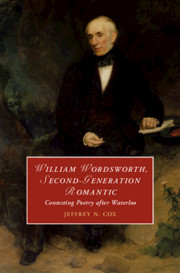Book contents
- William Wordsworth, Second-Generation Romantic
- Cambridge Studies in Romanticism
- William Wordsworth, Second-Generation Romantic
- Copyright page
- Dedication
- Contents
- Figures
- Acknowledgments
- Abbreviations
- Introduction
- Chapter 1 Cockney Excursions
- Chapter 2 Wordsworth’s “Thanksgiving Ode”
- Chapter 3 “This Potter-Don-Juan”
- Chapter 4 Thinking Rivers
- Chapter 5 Late “Late Wordsworth”
- Postscript Wordsworth in 1850
- Notes
- Select Bibliography
- Index
- Cambridge Studies in Romanticism
Chapter 5 - Late “Late Wordsworth”
Published online by Cambridge University Press: 10 June 2021
- William Wordsworth, Second-Generation Romantic
- Cambridge Studies in Romanticism
- William Wordsworth, Second-Generation Romantic
- Copyright page
- Dedication
- Contents
- Figures
- Acknowledgments
- Abbreviations
- Introduction
- Chapter 1 Cockney Excursions
- Chapter 2 Wordsworth’s “Thanksgiving Ode”
- Chapter 3 “This Potter-Don-Juan”
- Chapter 4 Thinking Rivers
- Chapter 5 Late “Late Wordsworth”
- Postscript Wordsworth in 1850
- Notes
- Select Bibliography
- Index
- Cambridge Studies in Romanticism
Summary
The final, two-part chapter treats the arc of Wordsworth’s poetry after 1820 up to his final volume of original poetry, Poems, Chiefly of Early and Late Years, in 1842. Treating explicitly the issue of Wordsworth’s age and the issue of the “late Wordsworth,” the first part of this chapter takes up his process of retrospection – looking back at his life – and re-collection – changing, reordering, and recombining his literary corpus. It touches upon the Ecclesiastical Sketches and Yarrow Revisited, And Other Poems.The second part treats “Memorials of a Tour in Italy, 1837,” an account Wordsworth’s long-delayed tripto Italy. Ironically, during the period of Wordsworth’s life when his poetry strikes us as being the least compelling aesthetically, he was probably at his most persuasive as a force within his own culture and society. Cox shows that the Italian memorials are an opportunity for Wordsworth to assert the power of his poetry in confronting not only a powerful cultural Other in Catholic Italy but also an Other Italy found or invented by Keats, Shelley, Hunt, and particularly Byron, ironically his younger precursors on this ground. Taking up topics from Wordsworth’s relationship to tourism to the religious valence of these last poems, this chapter concludes the overall argument that “late” Wordsworth developed in response to his younger contemporaries.
- Type
- Chapter
- Information
- William Wordsworth, Second-Generation RomanticContesting Poetry after Waterloo, pp. 157 - 199Publisher: Cambridge University PressPrint publication year: 2021

